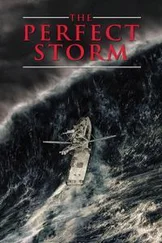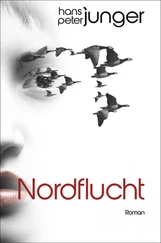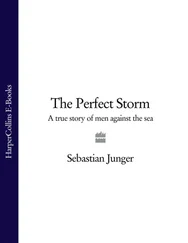Four in the morning, the air soft as silk. I’m speeding along the dark roads in a rented jeep, slowing down just enough to survive the speed bumps. The northern part of Bequia is almost completely uninhabited, steep, scrub-choked valleys running up to cliffs of black volcanic rock. Shark Bay, Park Bay, Brute Point, Bullet. Between the headlands are white-sand beaches backed by cow pastures and coconut groves. The road passes a smoldering garbage dump, climbs the island’s central ridge, and then curves into Port Elizabeth. The only signs of life at this hour are a few dockworkers loading a rusted interisland cargo ship under floodlights. The road claws up a hill and then crests the ridge above Lowerbay—Lowby, as it’s called—and starts down toward Friendship.
A dry wind is blowing through the darkness, and the surf against Semples Cay and St. Hilaire Point can be heard a mile away. I pull off the road near Ollivierre’s house and feel my way down a steep set of cement stairs to the water’s edge. The surf smashes white against the outer reefs; everything else is the blue-black of the tropics just before dawn. The whalers arrive ten minutes later, as promised, moving single file down the beach. They stow their gear without a word and put their shoulders to the gunwales of the Why Ask; she rolls heavily over four cinnamonwood logs and slips into the sea. The wind has abated enough to sail to the preferred lookout on Mustique; otherwise we’d have to make do with the hill above Ollivierre’s.
Within minutes they’re under way: Captain Dan at the tiller, Ollivierre up front, and Biddy Adams, Eustace, Arnold Hazell, and Kingsley Stowe amidships. They pull at the eighteen-foot oars, plunging into the surf. Once clear of the reef they step the mast, cinch the shrouds, becket the sprit and boom. They scramble to work within the awkward confines of the boat as Ollivierre barks orders from the bow.
The Why Ask is heartbreakingly graceful under sail, as much a creature of the sea as the animals she’s designed to kill. She was built on the beach with the horizon as a level and Ollivierre’s memory as a plan. Boatwrights have used such phrases as “lightly borne” and “sweet-sheared and buoyant” to describe whaleboats of the last century, and they apply equally to the Why Ask.
The boat quickly makes the crossing to Mustique, where the crew spends half the day on a hilltop overlooking the channel. With an older whaler named Harold Corea stationed above Ollivierre’s house with a walkie-talkie, they have doubled the sweep of ocean they can observe. In addition, they often get tips from fishermen, pilots, or people who just happen to look out their windows at the right moment. These people are always rewarded with whale meat if the chase is successful.
In the early days, between 1880 and 1920, there were nine shore whaling stations throughout the Grenadines, including six on Bequia, and together they surveyed hundreds of square miles of ocean. They’d catch perhaps fifteen whales in a good year, a tremendous boon to the local economy. In 1920, 20 percent of the adult male population of Bequia was employed in the whaling industry.
Five years later all that changed; a Norwegian factory ship set up operation off Grenada and annihilated the humpback population within a year and a half. Almost no whales were caught by islanders between 1925 and 1948, and none at all for eight years after that. The whaling stations folded one by one, and by the 1950s only the Ollivierre family was left. Today the humpback population has recovered slightly—the IWC now considers the species “vulnerable” rather than “endangered”—but sightings off Bequia are still rare. Last year the crew put out after a whale only once; so far this season they have yet to see a spout.
The boat returns from Mustique in the afternoon with nothing to report. The crew shrugs it off: Waiting is as much a part of whaling as throwing the harpoon.
On those lucky occasions when Ollivierre spots a whale from Mustique, he fixes its position in his mind, sails to the spot, and waits. If there’s no wind, the crew is at the oars, pulling hard against oarlocks that have been lined with fabric to keep them quiet. Humpbacks generally dive for ten or fifteen minutes and then come up for air; each time they do, Ollivierre works the boat in closer. The harpoon, protected by a wooden sheath, rests in a scooped-out section of the foredeck called the clumsy cleat; when the harpoon is removed, it fits the curve of Ollivierre’s thigh perfectly.
The harpoon is heavy and brutally simple. A thick cinnamonwood shaft has been dressed with an ax and pounded into the socket of a throwing iron. The head itself is made of brass and has been ground down to the edge of a skinning knife; it is mounted on a pivot and secured by a thin wooden shear pin driven through a hole. Upon impaling the whale, the pin breaks, allowing the head to toggle open at ninety degrees, catching deep in the flesh of the whale. It’s a design that hasn’t changed in 150 years. The harpoon is attached to a nine-fathom nylon tether, which in turn is tied—“bent,” Ollivierre says—to the manila main line, which is 150 fathoms long. The line passes through a notch in the bow, runs the length of the boat, takes two wraps around the loggerhead, and is coiled carefully into a wooden tub. The loggerhead is a hefty wooden block that provides enough friction to keep the whale from running out the entire tub of rope. When a whale is pulling the line, Eustace scoops seawater over the side and fills the tub; otherwise the friction will set the loggerhead on fire. Meanwhile, Ollivierre takes his position in the bow, delivering orders to Captain Dan in a low, harsh voice. Above all, they must stay clear of the tail: It’s powerful enough to launch a humpback clear out of the water and could obliterate the boat in a second. Ollivierre’s leg is braced against the clumsy cleat, and the other men are wide-eyed at the gunwales, the rank smell of whale vapor in their faces. The harpoon has been rid of its sheath, and Ollivierre holds it aloft as if his body has been drawn like a bow, right hand cupping the butt end, left hand supporting the shaft. You don’t throw a harpoon; you drive it, unloading it downward with all your weight and strength the moment before your boat beaches itself—“wood to blackskin”—atop the whale.
“De whale make no sound at all when you hit it. It just lash de tail and it gone,” says Ollivierre. “Dan let go of everything an put his two hands on de rope. De whale have to take de rope from him; he have to hold it down.”
A struck whale gives a few good thrashes with its tail and then tries to flee. It is a moment of consummate chaos: the line screaming out through the bow chock; the crew trying to lower the mast; the helmsman bending the line around the smoking loggerhead. Some men freeze, and others achieve ultimate clarity. “After we harpoon it, that frightness, that cowardness go from me,” says Harold Corea, who at sixty-three is one of the oldest members of the crew. “It all go away; I become brave, I get brave.”
Brave or not, things can go very wrong. Around 1970—Ollivierre doesn’t remember exactly when—a whale smacked the boat with a fluke, staving in the side and knocking Ollivierre out cold. When he came to, he realized that the rope had grabbed him and turned his leg into a loggerhead. It sawed down to bone in an instant, cauterizing the arteries as it went, and nearly ripped his hand in half. Ollivierre refused to cut the rope because he didn’t want the whale to get away, but finally the barnacle-encrusted fluke severed it for him. The boat returned to shore, and Ollivierre walked up the beach unassisted, his tibia showing and his foot as heavy as cement. Two men on the beach fainted at the sight.
Читать дальше












